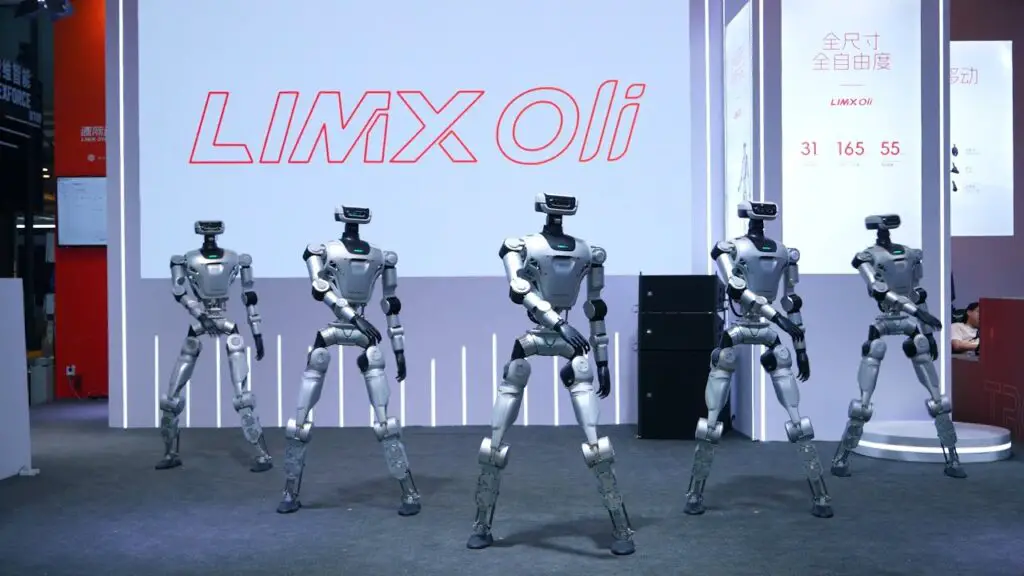The debut of the LimX Oli robot performance at the World Robotics Conference 2025 has pushed the boundaries of what humanoid robots can achieve. Instead of showcasing only mechanical power or industrial skills, Oli, the full sized humanoid robot from LimX Dynamics, captivated a global audience with ballet inspired dance moves.
This moment did not just display technical mastery it blended robotics with performance art, igniting curiosity about the future of human robot interaction. China has been steadily climbing to the forefront of global robotics, and LimX Oli robot performance is the latest example of its ambition.
Developed by LimX Dynamics, a Chinese robotics company known for its research in AI and humanoid design, Oli is not simply a machine it’s a performer. During its debut, Oli appeared as the lead member of a robot dance crew, executing choreographed movements that resembled ballet.
From graceful spins to delicate arm gestures, the robot stunned onlookers with precision and artistry. The company confirmed on its official YouTube channel that the performance was done live in front of a large audience. For many, this shifted the way robots are viewed from mechanical tools to participants in culture and art.
Why Dance Is a Breakthrough
Experts believe that dance is far more than just entertainment. It is a benchmark for robotic precision, balance, and adaptability. Dr. Li Zhang, Robotics Professor at Tsinghua University, explained. When a robot can perform ballet, it demonstrates mastery of balance and rhythm. These are skills that can directly transfer to fields like healthcare, elder care, and disaster rescue.
The fact that Oli danced in real time shows that humanoid robotics is maturing quickly. Meanwhile, Professor Emily Carter of MIT offered a global perspective. The significance of the LimX Oli robot performance is not just technological but cultural.
Dance requires fluidity and expression, qualities that humans associate with creativity. By achieving this, Oli proves that robots can engage with society in deeper, more meaningful ways.
Ballet as the Ultimate Robotics Challenge
When robots perform tasks like lifting or walking, the focus is on raw mechanics. But ballet is different it demands precision, emotional projection, and synchronization with rhythm.
A useful comparison can be made with Boston Dynamics’ Atlas, which gained global fame for parkour and gymnastics. While Atlas emphasized strength and agility, Oli’s ballet performance showcased grace and emotion, bridging a gap between technology and culture.
This suggests that future robotics competitions may not just be about speed or endurance but also artistic expression. Oli’s dance could set the stage for new benchmarks in evaluating humanoid development.
Technology Behind the Moves
The LimX Oli robot performance was powered by a combination of cutting edge robotics and artificial intelligence. AI Motion Algorithms Oli used advanced machine learning to sync movements with music in real time. Precision Actuators These allowed for fluidity in movements.
Enabling ballet like gestures. Balance and Sensor Systems To maintain poise on stage, Oli used gyroscopic stabilization similar to human equilibrium. Human Robot Interaction Software Ensuring that the performance didn’t appear mechanical but natural and expressive.
This combination represents the cutting edge of robotics research, transforming machines from industrial workhorses into cultural performers.
The audience at the World Robotics Conference 2025 was left mesmerized. Many attendees admitted they expected a standard tech demo but were met with something almost poetic.
Mei Lin, a university student in Beijing, shared. When Oli lifted its arms like a ballerina, it felt like watching a human dancer. I forgot for a moment it was a robot. That’s when I realized technology can be beautiful. Some even described the performance as emotional, suggesting that the boundary between machine and art is thinning.
What the Performance Means for the Future
The LimX Oli robot performance is not just about dance it signals a future where humanoid robots could participate in different aspects of society.
Entertainment Robots joining humans in live shows, theater, or even movies. Healthcare Using movement precision to assist in physical therapy for patients.
Education Teaching children art, rhythm, and dance through interactive performances. Cultural Diplomacy Showcasing a nation’s technological progress on global stages.
China, through LimX Dynamics, is showing that innovation in robotics is not only about efficiency but also about creativity and soft power.
Can Robots Truly Create Art?
While the performance was breathtaking, some experts caution that robots still mirror human creativity rather than generating it. Dr. Wei Huang, Cultural Anthropologist, explained. Robots like Oli can perform dance, but the question is can they feel it?
For now, it’s humans programming artistry into machines. The philosophical debate is whether we should call this ‘robotic art’ or simply a new extension of human expression.
This debate will continue as humanoid robots become more advanced. Still, the LimX Oli robot performance has made one thing clear humans and robots can share cultural spaces.
A Stage Shared by Humans and Robots
The world witnessed history when Oli danced before thousands at the World Robotics Conference 2025. The LimX Oli robot performance showed that robots can be graceful, expressive, and captivating not just functional machines.
By merging engineering with art, LimX Dynamics has opened a new chapter in robotics. As the line between human creativity and machine precision blurs, performances like Oli’s ballet may soon become common.
The stage, once only for humans, now belongs to robots too and together, they may redefine the meaning of art in the 21st century.

